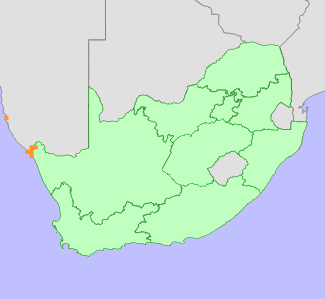|
Scientific Name | Dregeochloa pumila (Nees) Conert |
Higher Classification | Monocotyledons |
Family | POACEAE |
Synonyms | Danthonia pumila Nees |
National Status |
Status and Criteria | Critically Endangered A2ac+4ac |
Assessment Date | 2022/10/04 |
Assessor(s) | P.C.V. Van Wyk, N.N. Mhlongo & D. Raimondo |
Justification | This species has experienced a population reduction of approximately 90% due to drought-related mortality from the extended drought. It has additionally lost 50% of suitable habitat due to mining and urban development in Alexander Bay over the last two generations (100 years). It is projected that it will lose 80% of remaining suitable habitat within the next generation (50 years) as it falls within an area earmarked for development. It therefore qualifies for listing as Critically Endangered under criterion A. This species also occurs in Namibia however the subpopulations there are declining due to drought and mining. The regional status is therefore not downgraded. |
Distribution |
Endemism | Not endemic to South Africa |
Provincial distribution | Northern Cape |
Range | This species is found just north of Port Nolloth in the Northern Cape and extends into Lüderitz south of Namibia. |
Habitat and Ecology |
Major system | Terrestrial |
Major habitats | Western Gariep Lowland Desert, Western Gariep Plains Desert |
Description | Plants grow in rocky areas and loose sand and are restricted to narrow coastal belt that is subjected to sea mists. |
Threats |
| In the Northern Cape, the species grows mostly in areas that are not utilized for livestock grazing. This threat is therefore suspected to have a low impact on the population. The Grootderm subpopulation is threatened by habitat loss due to severe overgrazing which has resulted in massive loss of vegetation cover and its former habitat is now covered by wind blown sands. The species is also severely threatened by the ongoing drought which has resulted in a population reduction of approximately 90% within its South African range. At least 50% of this species' habitat in South Africa is likely to have been lost due to mining and urban development for Alexander Bay. The species' range falls completely within the development area of the Boegoebaai Port Project and the linked proposed green hydrogen plant. There is also a green hydrogen project planned for Namibia, however the extent is not yet known. |
Population |
The South African population is declining rapidly mainly due to drought, which has resulted in a 90% population reduction. Habitat loss due to mining and urban development has also affected this species across its South African range. The species may have been common south of Alexander Bay in the Alexander Bay strand veld vegetation, where there was a complete loss of vegetation between 1960 and 1990. The remaining species' range within South Africa falls entirely within an area earmarked for the Boegoebaai Port Project which will result in at least 80% of this species' habitat being irreversibly transformed within South Africa. Fortunately, it also occurs across the Sperrgebiet region where there has been some decline due to mining and drought. However there are unimpacted subpopulations in Namibia. Overall, the population is suspected to have declined by 40-50% in the past 100 years and with a future 50% loss projected in the next 50 years.
|
Population trend | Decreasing |
Notes |
| This is a region of extremely low winter rainfall (ca. 50 mm), however, sea mists are frequent. Occurs in very sparse Succulent Karoo Veld.
Number of known populations: Unknown.
Number of individuals in each population: Locally common.
Population trends, vigour and status: Some populations have probably been destroyed and others may be declining. |
Assessment History |
Taxon assessed |
Status and Criteria |
Citation/Red List version | | Dregeochloa pumila (Nees) Conert | Least Concern | Raimondo et al. (2009) | | Dregeochloa pumila (Nees) Conert | Vulnerable | Hilton-Taylor (1996) | |
Bibliography |
Hilton-Taylor, C. 1996. Red data list of southern African plants. Strelitzia 4. South African National Botanical Institute, Pretoria.
Raimondo, D., von Staden, L., Foden, W., Victor, J.E., Helme, N.A., Turner, R.C., Kamundi, D.A. and Manyama, P.A. 2009. Red List of South African Plants. Strelitzia 25. South African National Biodiversity Institute, Pretoria.
Snijman, D.A. 2013. Plants of the Greater Cape Floristic Region 2: The extra Cape flora. Strelitzia 30. South African National Biodiversity Institute, Pretoria.
|
Citation |
| Van Wyk, P.C.V., Mhlongo, N.N. & Raimondo, D. 2022. Dregeochloa pumila (Nees) Conert. National Assessment: Red List of South African Plants version 2024.1. Accessed on 2025/11/12 |
 Comment on this assessment
Comment on this assessment


